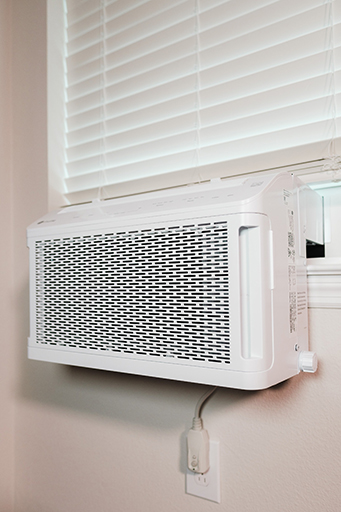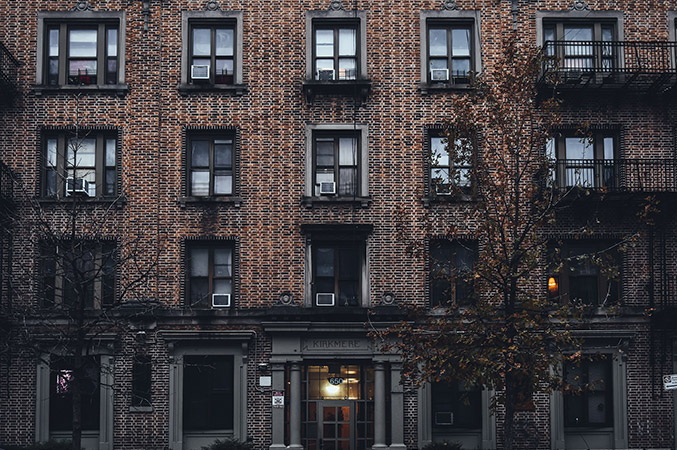People in New York City in the summer. (Photo courtesy of Ayaka Kata of Pexels)
In summer 2020, air conditioning (AC) units were distributed to low-income residents over age 60 in New York City (NYC) to combat the health effects of extreme heat during the pandemic. Since the program’s implementation, a team of researchers, community organizations, and city officials partnered to evaluate the program’s success. An April 2023 paper paper describes the program and the positive effects it had on residents’ health. The study was partially funded by NIEHS through the Center for Environmental Health in Northern Manhattan at Columbia University.
Distributing AC Units to Vulnerable Residents
Extreme heat is especially dangerous for people with existing chronic health conditions, older adults, and those without cooling resources, such as in-home AC. Individuals exposed to high temperatures may experience adverse health outcomes and, in extreme cases, death. From 2010 to 2018, an average of 350 NYC residents died each year from heat-related illness, according to study authors.
NYC officials developed the AC unit distribution program, a more expansive effort than traditional cooling assistance programs, in response to the twin issues of extreme heat and COVID-19-related recommendations to stay home and avoid indoor public spaces, including cooling shelters.
NYC government agencies, including Emergency Management, the Housing Authority, the Department of Health and Mental Hygiene, and the Department of Housing Preservation and Development Authority, worked together to distribute free ACs to low-income residents over the age of 60 and low-income residents with a registered mobility impairment. During summer 2020, Emergency Management installed 16,000 AC units in households in public housing, and 56,000 units in private households.
Participating agencies enrolled eligible residents who were already receiving benefits through the agencies. Community organizations that supported housing programs also enrolled residents. More than 100 organizations enrolled approximately 5,000 individuals. Eligible residents were also able to enroll themselves.
Determining Equitable AC Distribution and Health Outcomes

An example of a window air conditioning unit, similar to units installed in this program. (Photo courtesy of Airam Dato-on of Pexels)
Columbia University Mailman School of Public Health researchers and WE ACT for Environmental Justice evaluated the distribution program to determine the extent to which AC units were equitably distributed to vulnerable residents. Researchers used NYC’s Heat Vulnerability Index to compare AC distribution to the index’s map of residents most at-risk of adverse outcomes from heat exposure. The index uses five measures to rate a neighborhood from lowest to highest risk:
- Daytime summer surface temperature.
- Green space.
- Neighborhood poverty levels.
- Percentage of households with AC.
- Percentage of residents who are low-income or non-Latinx Black.
Researchers also compared AC distribution to neighborhoods with the highest COVID-19 morbidity and mortality and other public health inequities, measurements that were developed by the NYC Task Force for Racial Inclusion and Equity.
Mapping results determined that ACs were distributed to areas that needed them most. Areas ranking high on the Heat Vulnerability Index were more likely to receive ACs than lower-risk areas. Areas with the most illness and death from COVID-19 were also more likely to have ACs installed through the distribution program, and installation rates were highest in areas with more older adults living below the poverty limit.
“We visualized the AC distribution intervention to determine if it was effectively targeted,” stated Diana Hernández, Ph.D., associate professor of sociomedical sciences at Columbia University Mailman School of Public Health and member of the NIEHS Environmental Health Sciences Core Center. “This gave us a way to observe if the program met environmental justice goals of reaching the most marginalized residents. We were happy to see that AC distribution aligned closely to vulnerable areas and serving populations most in need.”
To further evaluate the AC distribution program, the research team surveyed a sample of program participants and a comparable group of non-participants. The team developed the survey in collaboration with community organizations. The survey asked respondents to reflect on whether they felt sick while staying home in the summer, to indicate their health status, and to describe where and how they kept cool during summer months in 2019 and 2020 to compare the AC distribution period with the prior summer.

An apartment building in New York City with air conditioning units. (Photo courtesy of RealStash of Pexels)
During 2019, both groups stayed home at approximately the same rate. However, more AC recipients than comparison group participants stayed home during summer 2020, suggesting that people who received ACs were more able to protect themselves from heat while complying with social distancing guidance. Survey results also indicated that non-participants were more likely than program participants to report that they or someone in their household felt sick due to heat.
“The survey results showed us that getting an AC unit had a positive effect on health during a summer when there were fewer public, cooled spaces available,” reflected Kathryn Lane, senior environmental epidemiologist at the NYC Department of Health and Mental Hygiene. “The program was a joint COVID-19 and heat emergency response measure, but the outcomes are relevant for heat adaptation generally.”
Her colleague, Carolyn Olson, assistant commissioner of the Bureau of Environmental Surveillance & Policy at the NYC Department of Health and Mental Hygiene, further noted, “Having an AC at home helped recipients stay safe from heat in 2020, but it also has a long-term benefit as summers continue to get even hotter and having access to cooling at home can protect health and save lives.”
The large-scale AC distribution program occurred only during summer 2020, but New York State and NYC still manage programs to help low-income residents get free AC units. The results of the evaluation of the 2020 program indicate that such programs will help residents at risk of heat-related adverse health outcomes receive the support they need to stay safe in hot weather. As cities grapple with increasing extreme heat due to climate change, the NYC AC distribution program provides a model for supporting those most in need.
“This program is an example of how AC distribution can successfully meet a community’s needs by prioritizing distribution to those most vulnerable to heat,” stated Sonal Jessel, director of policy at WE ACT for Environmental Justice. “We are happy AC distribution continues in NYC and look forward to seeing how NYC and other cities help residents adapt to the effects of climate change.”
Source link
www.niehs.nih.gov

